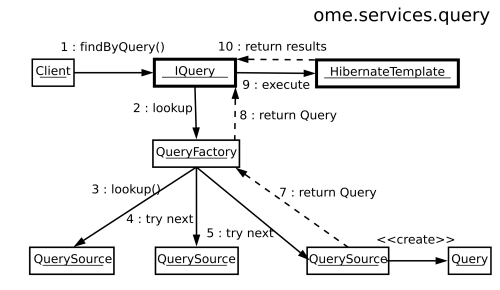Note
This documentation is for the new OMERO 5.4 version. See the latest OMERO 5.3.x version or the previous versions page to find documentation for the OMERO version you are using if you have not upgraded yet.
Using server queries internally¶
Overview
This page is aimed at internal server developers and does not contain information for how to perform API queries. If that is the kind of information you are looking for, you may find OMERO Application Programming Interface more useful as a starting point.

omero.services.query
Introduction¶
The ome.services.queries package is intended to allow for the easy definition of queries by both developers and clients. Due to the fragility of HQL defined queries, a framework allowing for easy definition, multiple formats (Velocity templates, Database values, class files), and transparent lookup is critical.
Lookup happens among all QuerySources that are registered with the QueryFactory instance present in OMERO services. The first non-null Query instance returned by a QuerySource for a given String id is used.
Queries implement the HibernateCallback interface and are passed directly into an HibernateTemplate instance. Therefore, care should be taken as to which QuerySources are registered with the QueryFactory.
Parameters¶
Critical for using queries is the specification of named parameters, number of results to return, offset of the first result to return etc. These features are offered by the ome.parameters package. The ome.parameters.Parameters class is the starting point for building new parameters (although the ome.parameters.Filter object is used by some methods).
To specify parameters, instantiate a Parameters object either with or without a Filter object argument. The version with Filter object is useful for specifying the number of results to be returned and whether or not a java.util.Collection or a ome.model.IObject instance will be returned. For example,
Parameters p = new Parameters( new Filter().unique() );
will specify that the given query should return a single instance. An exception will be thrown if more than one result is found.
Parameters p = new Parameters( new Filter().unique().page(0,1) );
However, this will guarantee that only one result will be returned, since more than 1 result (“maxResults”) will be ignored. Here, an ordering of the results might make sense.
Once a Parameters instance is available, named parameters can be added using any of the add…() methods. These parameters will be dynamically bound during query preparation. For example, a query of the form:
select e from Experimenter e where omeName = :name
has one named parameter “name”, which can be specified by the call:
parameters.addString("name","<myNamHere>");
Positional parameters of the form
select e from Experimenter where omeName = ?
are not supported.
Adding queries¶
Subclassing query¶
Other than by defining String queries via new QueryDef() TBD, the easiest way to create queries is to subclass ome.services.query.Query. The only non-optional requirements on the Query implementor are then to define the (possibly optional) named parameters to the Query, and to override the “buildQuery” (which must call one and only one of “setQuery()” or “setCriteria()”)
Other than that, the Query implementor can enable filters on the Hibernate session (an attempt is made to clean up after the Query runs), and in general use any of the Hibernate session methods.
Defining a QuerySource¶
A more involved but perhaps more rewarding method would be to implement QuerySource and configure QueryFactory to lookup query ids also in your QuerySource. This would allow you to write Velocity (or Freemarker/Ruby/Python/Groovy…) QuerySources which use some form of templating or scripting to generate HQL queries.